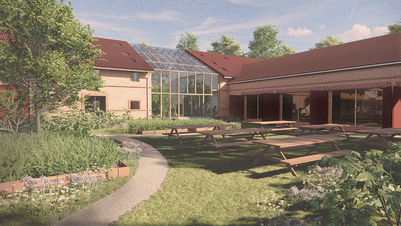
Coronablog on the Periphery | Kirsten Marie Raahauge

INSTITUTION AESTHETICS AND WELFARE SPACES: SDU MEETS SDW
The day before the corona lockdown, some of the researchers behind the research program Design Culture (Niels Peter Skou, Anders Munch, Tau Ulv Lenskjold, Annette Svaneklink Jakobsen, Hans-Christian Jensenand others) at The University of Southern Denmark and some of the researchers from Spaces of Danish Welfare (Martin Søberg and Kirsten Marie Raahauge) held a workshop in Kolding in order to explore the interfaces between institution aesthetics and welfare spaces. A number of intersections were discussed.
The Design Culture group take their point of departure in the rise of ‘public design’ as a specific field of design, which has been intertwined with the role of institutions in the welfare state through the years. Here, architecture and design has had a part to play in the shaping of public projects. As part of this development, the field of ‘institution aesthetics’ might be pointed to as a specific field of design, which was shaped through the institutions of the welfare state.
The character of this kind of design is recognizable, still, the notion ‘institution aesthetics’ is difficult to define. Furthermore, furniture designed for institutions have become part of many homes, while also objects designed for the private sphere are to be found in institutions. Also, social relations that used to take place in private spheres have been institutionalized throughout the 20th centuries, through for example nursing homes or day care centers.
This field brings forth questions of the transformation of design and the changes of interiors of institutions as well as private interiors. All these changes are related to the structural reorganization of welfare spaces. These intertwinements open up for inquiries into the impact of institutions on aesthetics, design, private spheres, and the welfare state – and vice versa. Both inside the disciplines of design and architecture and on a broader societal level, the institution, institution aesthetics and welfare spaces have consequences in many parts of society. It touches upon ideas about private and public, on history and the ways in which yesterdays’ design has been interpreted in contemporary settings, and also it touches upon the spatial transformations that take place through the interplay of these components.
In concrete empirical settings of institutions and design through time and in different parts of Denmark, the impact of these elements is explored, albeit through different perspectives by the Design Culture-group and by Spaces of Danish Welfare. This workshop was only the first encounter, more will follow, I am sure. Meanwhile, a short passage from my inaugural lecture from February 2020 (Raahauge in press (2020)), since it deals with some of the aspects of these topics:
“A welfare space is never only a welfare space, it is always also something else, a place where you meet someone, a place where you get a life changing message, a place where you distribute some kind of amenity, a place where you show case welfare, a place where you have your private corner, and all of this is shaped into a certain kind of recognizable space: the school, the hospital, the collective housing etc. You might read about one of these spaces in Mette Jerl Hansen and Kjeld Vindum’s article on waiting rooms and their permanent state of bad design (Jensen and Vindum 2017). Public, private, representational, intimate, collective, individual, functional, cozy, grand, shabby, intense, hyggelig or uncanny; interiors, often understood by way of their function, hold layers of sensations, actions, relations, implications, imaginaries, and spaces inside the space. There might be a master signifier that rules your overall idea of this particular space, as for example welfare, but the interior is never only this. It is always also that, since various uses, imaginaries and sensations merge. […] Welfare spaces should be accessible by the one who needs them, and as they in principle are there for everybody, they also tend towards a universal, collective, orderly, neutral form language, which is of course nonsense, since neither universality nor neutrality is an option in design, still it is part of the idea behind the design. Maybe, the impossibility of universality or neutrality in design is why those waiting spaces are impossible to design.”
Jensen, Mette Jerl & Kjeld Vindum
2017 The Waiting Room as Welfare Design. I: J. R. Bendsen, M. J. Jensen, K. Lotz, K. M. Raahauge, D. Simpson & K. Vindum (red.): Form til velfærd. Side 236-252. København: Arkitektens Forlag.
Raahauge, Kirsten Marie (in press (2020)) Tiltrædelsesforelæsning: Rumantropologier: I velfærdens, hjemmenes og hjemsøgelsernes verden [Inaugural lecture: Spatial Anthropologies. In the Realm of Welfare, Homes and Haunting], in Teknologi I, Tidsskriftet Antropologi nr. 81. 2020.















